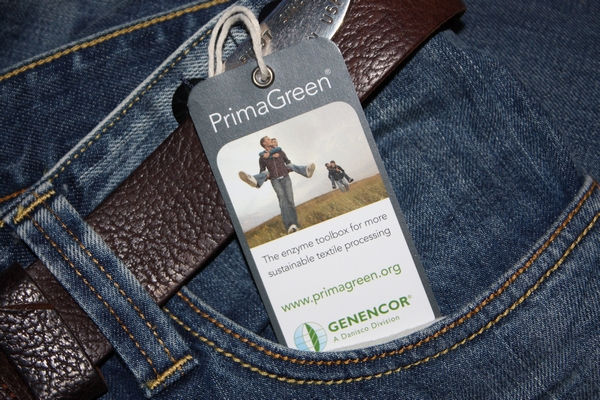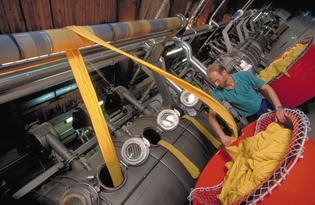Humankind has used enzymes for thousands of years to carry out important chemical reactions for making products such as cheese, beer, and wine. Bread and yogurt also owe their flavor and texture to a range of enzyme producing organisms that were domesticated many years ago.
In the textile industry, one of the first areas which enzyme research opened up was the field of desizing of textiles. A size is a substance that coats and strengthens the fibers to prevent damage during the weaving process. Size is usually applied to the warp yarn, since this is particularly prone to mechanical strain during weaving. The size must be removed before a fabric can be bleached and dyed, since it affects the uniformity of wet processing. Previously, in order to remove the size, textiles were treated with acid, alkali or oxidising agents, or soaked in water for several days so that naturally occurring microorganisms could break down the starch. However, both of these methods were difficult to control and sometimes damaged or discoloured the material. But by using enzymes, which are specific for starch, the size can be removed without damaging the fibers.
It represented great progress, therefore, when crude enzyme extracts in the form of malt extract, or later, in the form of pancreas extract, were first used to carry out desizing. Bacterial amylase derived from Bacillus subtilis was used for desizing as early as 1917. Amylase is a hydrolytic enzyme which catalyses the breakdown of dietary starch to short chain sugars, dextrose and maltose.
Enzymes have been used increasingly in the textile industry since the late 1980s. Many of the enzymes developed in the last 20 years are able to replace chemicals used by mills. The first major breakthrough was when enzymes were introduced for stonewashing jeans in 1987 – because more than one billion pairs of denim jeans require some sort of pre-wash treatment every year. Within a few years, the majority of denim finishing laundries had switched from pumice stones to enzymes.
Today, enzymes are used to treat and modify fibers, particularly during textile processing and in caring for textiles afterwards. They are used to enhance the preparation of cotton for weaving, reduce impurities, minimize “pulls” in fabric, or as pre-treatment before dying to reduce rinsing time and improve color quality. New processing applications have been developed for:
- Scouring (the process of removing natural waxes, pectins, fats and other impurities from the surface of fibers), which gives a fabric a high and even wet ability so that it can be bleached and dyed successfully. Today, highly alkaline chemicals (such as caustic soda) are used for scouring. These chemicals not only remove the non-cellulosic impurities from the cotton, but also attack the cellulose leading to heavy strength loss and weight loss in the fabric. Furthermore, using these hazardous chemicals result in high COD (chemical oxygen demand) and BOD (biological oxygen demand) in the waste water. Recently a new enzymatic scouring process known as ‘Bio-Scouring’ is being used in textile wet-processing with which all non-cellulosic components from native cotton are completely or partially removed. After this Bio-Scouring process, the cotton has an intact cellulose structure, with lower weight loss and strength loss. The fabric gives better wetting and penetration properties, making the subsequent bleach process easy and giving much better dye uptake.
- One of the newest products, PrimaGreen® EcoScour from Genencor, offers sustainability advantages for eco-scouring in cotton pretreatment, including 30 percent water savings and 60 percent energy savings compared to standard processing. In addition, the mild processing conditions result in improved fabric quality and enhanced color brightness after dyeing.

- One of the newest products, PrimaGreen® EcoScour from Genencor, offers sustainability advantages for eco-scouring in cotton pretreatment, including 30 percent water savings and 60 percent energy savings compared to standard processing. In addition, the mild processing conditions result in improved fabric quality and enhanced color brightness after dyeing.
- Bleaching – When bleaching cotton, a lot of chemicals, energy and water are part of the process. The company Huntsman has developed a wetter/stabilizer that maximizes the wetting and detergency of the bleaching process and a one-bath caustic neutralizer and peroxide remover in order to shorten the bleaching cycle, reduce energy and water required and deliver more consistent bleaching results. They have developed surfactants that are environmentally friendly (in that they do not contain Alkylphenol ethoxylates), and the system is both Oeko-Tex and GOTS approved. After fabric or yarn bleaching, residues of hydrogen peroxide are left in the bath, and need to be completely removed prior to the dyeingprocess, using a step called bleach cleanup. The traditional method is to neutralize the bleach with a reducing agent, but the dose has to be controlled precisely. Incomplete peroxide removal results in poor dyeing with distinct change of color shade and intensity, as well as patchy, inconsistent dye distribution. Enzymes used for bleach clean-up ensure that residual hydrogen peroxide from the bleaching process is removed efficiently – a small dose of catalase breaks hydrogen peroxide into water and oxygen. This results in cleaner waste water and reduced water consumption.
- In 2010, a life-cycle assessment was completed comparing PrimaGreen enzymatic bleaching to conventional textile bleaching methods. According to this LCA, if the enzymatic system were to see wide scale global adoption, the potential savings in freshwater consumption could be up to 10 trillion liters of water annually, and greenhouse gas reductions could range from 10-30 million metric tons. (1)
- Biofinishing or biopolishing (removing fiber fuzz and pills from fabric surface) – enzymatic biofinishing yields a cleaner surface, softer handfeel, reduces pilling and increases luster;
- Denim finishing – In the traditional stonewashing process, the blue denim was faded by the abrasive action of pumice stones on the garment surface. Nowadays, denim finishers are using a special cellulase. Cellulase works by loosening the indigo dye on the denim in a process known as ‘Bio-Stonewashing’. A small dose of enzyme can replace several kilograms of pumice stones. The use of less pumice stones results in less damage to garment, machine and less pumice dust in the laundry environment; in addition, it’s possible to fade denim without risk of damaging the garment.
- European scientists have just announced a new and environmentally friendly way to produce textile dyes using enzymes from fungi. (2)
Because of the properties of enzymes, they make the textile manufacturing process much more environmentally benign. (3) Generally, they:
- operate under milder conditions (temperature and pH) than conventional process chemicals – this results in lower energy costs ( up to 120 kg CO2 savings per ton of textile produced) (4) ;
- save water – reduction of water usage up to 19,000 liters per ton of textiles bleached;
- are an alternative for toxic chemicals, making wastewater easier and cheaper to treat.
- are easy to control; do not attack the fiber structure with resulting loss of weight, resulting in better quality of material;
- better and more uniform affinity for dyes;
- contribute to safer working conditions through elimination of chemical treatments during production processes;
- are fully biodegradable.
So why is there a ruckus about enzymes being used in textile processing by GOTS and other organic certifying agencies?
(1) http://primagreen.genencor.com/sustainability/lca_results/
(2) http://www.just-style.com/news/eco-friendly-textile-dyes-use-enzymes-from-fungi_id112195.aspx
(3) http://www.textiletodaybd.com/index.php?pid=magazine&id=52


My concepts got cleared regarding using of enzymes thanks for your effort.
Nice Read! Loved the content. We are an enzyme manufacturing company based in India and we love to read topics related to enzyme and its uses.
Very useful blog on enzyme.it will be use full for all textile persons.